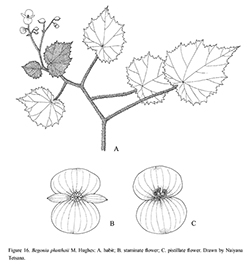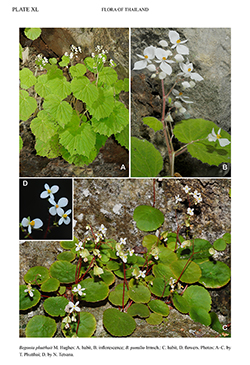e-Flora of Thailand
Volume 14 > Part 3 > Year 2019 > Page 406 > Begoniaceae > Begonia
35. Begonia phutthaii M.Hugheswfo-1000039718
[§ Apterobegonia], Edinburgh J. Bot. 74 (2): 149−161. 2017. Fig. 16. Plate XL: A–B.
Accepted Name : This is currently accepted.
Description : Monoecious caulescent herb, 10–30 cm tall. Stems succulent, erect or suberect, densely pubescent, pale green or pale purple-red; tubers globose or subglobose, 5–10 mm diam. with numerous fibrous roots. Leaves 6–8 per plant; petiole pale green, or pale to dark red, reddish brown when dry, 5–20 cm long; lamina basifixed, chartaceous, adaxial surface densely pubescent, light green or vinaceous-greenish, abaxial surface densely hairy especially on veins, green or dark vinaceous, asymmetrical, broadly ovate, 4–13 by 4–14 cm, base cordate, apex acute, margin irregularly dentate, venation palmate, veins 7 or 8. Stipules persistent, pale green or pale vinaceous, triangular, 4–5 by 2–2.5 mm, apex acute, margin entire, hairy. Inflorescences terminal, compound cymes, bisexual, branched 1–4 times, 4–13 cm long, with 4–6 staminate flowers and 2 pistillate flowers per branch, protandrous; peduncles 3–5 cm long, terete, densely pubescent, glossy. Bracts caducous, greenish pink, pale green, membranous, lanceolate, ca 1– 2 by 0.5–2 mm, apex acute or obtuse, margin entire, pubescent. Staminate flowers: pedicels 5–10 mm long, erect (or ascending); tepals 2 or 4(–5), crimson or pale pink or white, outer 2 orbicular, 4–10 by 5–10 mm, base rounded, apex obtuse or acute, margin entire, glabrous inside, hairy outside, inner 2 oblong, 4–5 by 2 mm, base cuneate, apex obtuse, margin entire, glabrous on both sides; androecium actinomorphic, globose, stamens 40–50, yellow, filaments ca 0.5 mm long, fused to androecium, anthers ca 0.5 mm long, oblong, dehiscing by short slits near tip. Pistillate flowers: pedicels pale crimson, 6–9 mm long; tepals 2–4(–5), same size and colour as the staminate flowers; styles 3, fused at base, stigmatic band kidney-shaped, surface once spirally twisted, yellow; ovary with 3 equal wings, pink or very pale green, densely pubescent, 3-locular, placentae unilamellate. Fruit a dehiscent capsule, pinkish white, pendulous, drying pale brown, 5 by 5–6 mm, dehiscent at end of wings; locules ovoid, 4–5 by 3–4 mm, 3 equal wings, crescent-shaped.
Thailand : NORTHERN: Mae Hong Son (Pang Ma Pha – type: Middleton et al. 5822, holotype -E, isotypes -BKF SING).
Distribution : Endemic.
Ecology : On damp and shaded limestone cliffs in seasonally dry evergreen forests. Flowering: May–November; fruiting: November–January.
Vernacular : Dat mueang nuea (ดาดเมืองเหนือ).
Notes: The epithet phutthaii is in recognition of the first author’s endeavours in the field and herbarium which have done so much to increase our understanding of Thai Begonia. The tepal number and shape varies within populations in this species; at the type locality individuals have both 2 and 4 (or 5) tepals in the male and female flowers, with either acute or obtuse apices. Moreover, the leaf colour in different populations in Chiang Rai and Mae Hong Son Provinces varies from pale light green to dark vinaceous according to conditions of shading and soil composition.


